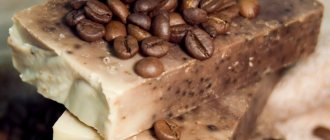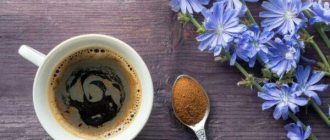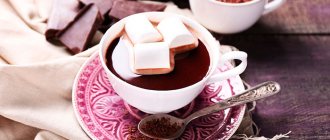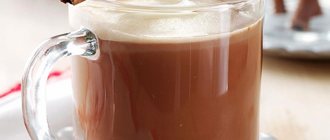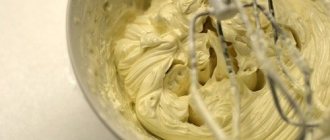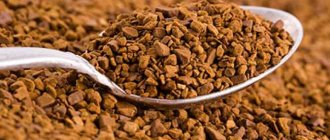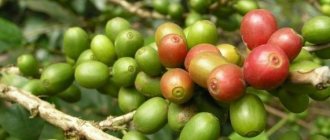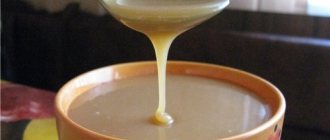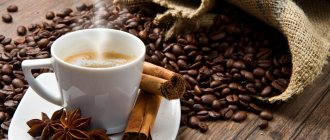The history of cocoa begins about three thousand years ago in the civilization of the ancient Olmec Indians, later moving on to the Aztecs and Mayans. The fruits of the chocolate tree were considered the food of the gods and were used by shamans exclusively for traditional rituals of the tribe, being an unaffordable luxury for ordinary people. But today this delicious drink is available to everyone, but it looks and is prepared completely differently.
What is cocoa
All children know that cocoa is the brown fruit of a tropical tree from which their favorite chocolate is made. For adults, this name combines several products:
- Cocoa butter
- Cocoa beans
- Cocoa powder
The term comes from the name of an exotic plant - Theobroma cacao. It is also called the chocolate tree. Theobroma is translated from ancient Greek as “food of the gods.” This epithet was invented by Carl Linnaeus, a Swedish scientist. The second part of the name has Indian roots. In the Aztec language it sounded like kakahuatl. Spanish historians of the 16th century described the chocolate tree under the name cacahuacahuitl (yes, it’s good that it came down to us in a shortened version).
Is it possible while losing weight?
Cocoa powder is a product that can be consumed when losing weight. The drink speeds up metabolism and also gives a quick feeling of fullness, which helps avoid overeating. Of course, for those losing weight, it is better to cook cocoa in water or use milk with a low fat content, but not skim milk: this is completely unhealthful.
The recommended dose of a drink made from natural cocoa powder is 500 milliliters per day. In this case, it is advisable to divide the intake into two times. It is also worth excluding granulated sugar from their drinks; it is better to use sweeteners.
Description of the cocoa tree and fruit
Theobroma is an evergreen tree of the Malvaceae family, native to the subequatorial forests of the South American continent. From there it spread to tropical parts of the world. Now it is grown in almost all countries of Southeast Asia, Africa, and Indonesia.
The tree is quite tall - 10-12 meters, with a spreading crown. The branches stretch out to the sides and upwards, trying to receive as much sunlight as possible. Sometimes the plant begins to branch from the very bottom. The leaves are large, oblong in shape. During the flowering period, small white-pink flowers appear, with long, curved petals, like an orchid. An interesting feature: they are attached directly to the trunk. After the tree flowers, large ellipsoidal fruits form on it. Their property of attaching not to branches, but to the stem part is called cauliflory.
The fruits of the chocolate tree are similar in shape to melons. They grow up to 30 cm in length. The peel is thick, dense, pleasant to the touch. Longitudinal furrows run along it. The internal space is filled with seeds attached to each other. They are surrounded by creamy pulp that has a sweet and sour taste. Seeds can number from 15 to 60 pieces.
Ripe fruits acquire yellow, red, brown shades. Trees produce crops year-round, throughout their lives, for 50-80 years. Each plant ripens 50-60 fruits. This is not much, considering that 80% of this amount is required to produce a kilogram of cocoa powder.
Use in cooking
Cooking is the main area where cocoa powder is used. This is due to the pleasant aroma and good taste of the product.
Chocolate additive is used for various purposes, for example:
- as an addition to chocolate mousses;
- to add color and flavor to the glaze;
- as an additive to creams;
- as an additive to dough;
- in the preparation of sweets, chocolate spreads and ice cream;
- as a simple and beautiful decoration for desserts.
Cocoa powder is also used as an additive to sauces, which are suitable even for meat dishes. And, of course, cocoa powder is used to make a tasty and aromatic drink.
In cooking, cocoa powder goes best with milk and cream. Additives such as vanilla and even hot pepper (ground) will highlight and complement the taste of the product. It is also common to add dried fruits and nuts to desserts based on cocoa powder.
How to brew cocoa powder?
Anyone can brew their own cocoa powder. You just need to decide what the base will be (milk or water), the rest is a matter of technique. You can cook one or two servings, or several liters. The finished drink can be stored in the refrigerator for several days.
On the water
If there is no milk in the house, but you want to drink cocoa, do not despair, a delicious drink can be prepared with water. You will need the following ingredients:
- water (250 ml);
- sugar (to taste);
- cocoa (1 teaspoon).
The proportions are indicated for one serving, they can be increased if desired. But you shouldn’t add too much cocoa: it won’t give you more flavor, but there will be a lot of sediment.
The process of preparing the drink is simple. First you need to put a container of liquid on the fire, which should boil. Meanwhile, in a separate bowl, mix cocoa powder and sugar. When the water becomes hot, pour 2-3 tablespoons of water into a bowl with sugar and cocoa. The resulting mass must be stirred thoroughly so that the sugar dissolves and there are no lumps. When the water boils, the prepared cocoa mixture should be poured there and boiled for 3-5 minutes, then removed from the heat, cool slightly - and you can drink.
With milk
Cocoa made with milk is much tastier than cocoa made with water. The cooking principle is the same, but the proportions can be adjusted. The milk is placed on low heat. The liquid should be stirred periodically to prevent it from running away. Sugar and cocoa powder are mixed in a separate bowl. When the milk warms up a little, add a small amount of it to the dry mixture and stir until a homogeneous consistency is obtained. And when the milk boils, the resulting mass is gradually introduced into it, stirring constantly.
You can also brew the drink with soy milk. This is true for those who are lactose intolerant. But preparing a drink with soy milk has some peculiarities. For example, the liquid should only be kept on low heat. Also, you should not boil it for a long time: cocoa should be removed from the stove as soon as it has gurgled several times.
If desired, the proportions of the liquid can be changed. For example, you can mix water and milk. What proportions it will be in is a matter of taste: you can take 50/50, or you can add a little more milk. You should navigate according to your taste. This trick will reduce the calorie content of the drink, if necessary.
How to make chocolate?
Making chocolate from cocoa powder is as easy as making a drink. And there are many fans of this sweet drink; now it is very often served in cafes, restaurants and coffee shops. You won't be able to make a hot chocolate drink with water, so you should immediately take care of the milk.
For one serving of the drink you will need the following ingredients:
- cocoa powder (2 tbsp);
- sugar (to taste);
- cream (100 ml)
- milk (250 ml).
Milk and cream should be poured into a container and put on fire, where the liquid should be heated, but not boiled. Sugar and cocoa powder should be mixed in a separate bowl. When the milky liquid becomes hot, add a small amount to the sweet mixture. After mixing everything until smooth, the mixture is poured into a container with hot milk and kept on fire until the sugar is completely dissolved, and then removed from the stove and drunk.
If you don’t need to add a lot of powder to a cocoa drink, then with chocolate things are different: the more product is added, the more pronounced the taste will be.
You can add grated ginger, hot pepper, vanilla and cinnamon to hot chocolate.
The following video will tell you in detail how chocolate bars are made from the cocoa tree.
How to make glaze?
A spectacular chocolate glaze will decorate any dessert, and it can be made from cocoa powder. The proportions of the components are adjusted depending on the size of the dessert.
To prepare regular glaze you will need:
- cocoa powder;
- water;
- granulated sugar (but it is better to use powdered sugar).
Pour powdered sugar and cocoa powder into a convenient container and place on the stove. The fire should be slow. After mixing the bulk ingredients, add water and mix everything again with a whisk. Stirring constantly, you need to bring the mass until it starts to bubble, and then remove it from the stove and cool a little, and then use it as a confectionery decoration.
The recipe described above is an example of a regular, classic glaze that turns out liquid, making it easy to work with. But there are some tricks that will help make chocolate decoration more interesting, and also with which you can correct some errors:
- If the glaze turns out to be too liquid and spreads over the surface of the product without stopping, then it should be thickened. This can be done by adding a few more tablespoons of powdered sugar. It's worth noting that powdered sugar not only helps thicken the icing, but also makes it more uniform. It is for this reason that it is recommended to use it rather than granulated sugar.
- And if the glaze, on the contrary, is thick, then it can be diluted with boiling water.
- To avoid the appearance of large lumps, cocoa powder should be sifted through a strainer.
- Butter will help give the glaze a creamy consistency and a mirror shine.
- If the glaze is made from cream or sour cream (at least 20% fat), then you should not put butter in it, as the taste may not be quite the same. In addition, you may not achieve the required consistency.
Some confectioners make glazes based on lemon or orange juice. In this case, any other liquid is completely excluded. Experienced confectioners claim that the mixture turns out aromatic and tasty.
But painting the mastic with cocoa powder will not work. More precisely, this can be done, but the color will be uneven. To color mastic, as a rule, special food dyes are used.
Where is cocoa grown?
Until the 19th century, the largest cocoa producers were Brazil, Venezuela and Ecuador. The plantations used black slave labor. Currently, the championship belongs to the African country of Côte d'Ivoire. Further performance indicators are distributed as follows (in descending order):
- Indonesia
- Ghana
- Nigeria
- Brazil
- Cameroon
- Ecuador
- Dominican Republic
In South American countries, yields are lower. The processed beans are exported to Europe and the North American continent. Almost 20% of imports come from the Netherlands and England. They are processed into more familiar products in importing countries.
Chemical composition
Cocoa powder is rich in substances beneficial to the body.
It is made from beans that are ground into a rich chocolate substance. Most of the fats are removed from the paste during the manufacturing process. It is then dried and ground again. Therefore, no harmful fats remain in the finished product. Natural cocoa powder has high nutritional value. 100 g of product contains:
- proteins - 24.3 g;
- fats - 15 g;
- carbohydrates - 10.2 g;
- fiber - 35.3 g;
- minerals - calcium and phosphorus, magnesium and potassium, iron and zinc, copper.
In total, cocoa contains more than 300 useful substances. It is noteworthy that it contains more zinc and iron than many other products. There are also tonic substances, including caffeine, but it is much less than in coffee.
Video: The benefits of cocoa. About the most important thing
cocoa beans
After ripening, the fruits are removed from the trunks with special wide knives - machetes. They also cut the thick peel and extract the beans. Wide banana leaves are laid out on the ground. Fresh cocoa seeds are placed on them to carry out the fermentation process (fermentation) and covered with a second layer of leaves.
The beans, covered with thick banana palm leaves, begin to ferment under the influence of the sun. The temperature between layers reaches 50 degrees. Natural fermentation of the beans occurs, converting natural sugar into carbon dioxide and an alcohol compound. During the process, the seeds lose their light shade and become a beautiful brown color.
After this, the drying of the beans begins. The top layer of leaves is removed to allow the seeds to dry in the sun. Currently, this process can occur using special heat exchange units. After drying, the seed acquires a chocolate aroma well known to consumers. The product is packaged in bags and transported to European countries.
Cocoa bean butter and powder are produced in factories. The shell is removed from the seeds, then they are pressed, squeezing out the oil. Powder is obtained from pressing waste. There is another product that is used in animal husbandry. This is a cocoa shell - a processed dry shell.
German technology
There are several ways in which you can obtain the powder. But one of the most advanced ones was invented in Germany. The powder is made quite quickly, since three stages - processing, drying and roasting - take place in one unit.
All this time the raw materials are kept closed. Air does not reach it, but an alkali solution is introduced in a special way, which is sprayed over the surface of the raw material:
How do cocoa beans grow?
- potash;
- sodium carbonate;
- potassium bicarbonate;
- sodium bicarbonate;
- ammonium carbonate.
In this simmering mode, you can get rid of the tannins contained in the raw material and prepare tender grains.
The temperature when processing with alkali is 85 degrees. The entire processing process occurs under the pressure of the unit’s own steam. This allows the solution to penetrate directly into the structure of the raw material. Thanks to the effect of alkali, pathogenic microorganisms and fungi are destroyed, which is very important for the health of consumers who use cocoa.
The color of cocoa depends on the degree of roasting of the raw materials
The resulting cereal is dried at a temperature of at least 100 degrees. This is necessary in order to heat the water and remove it from the raw material. Ultimately, a small amount of water should remain - up to two percent. As soon as the water evaporates, the temperature is increased by another 20-35 degrees and frying begins. At the same time, the cocoa becomes dark in color and gives off a characteristic chocolate aroma.
After frying, the raw material enters the unit, where it undergoes a cooling stage, the powder is mixed with blades, and excess air is removed using a fan. To improve the aroma, vanillin is added to cocoa powder. The resulting product is packaged, labeled and sent to store shelves.
Cocoa varieties
There are three main types of cocoa beans. All other varieties are their derivatives. It should be noted that this classification applies only to raw beans. After processing, they are divided according to bitterness, astringency, sweetness, etc.
Forastero
This type of product is considered to be of lower quality than others. That's why it's the cheapest. Due to its low cost, its exports account for 80% of the total market. Forastero is cultivated in African and South American countries. Do not conclude that Forastero is of poor quality. Just in terms of its characteristics, it does not belong to a premium product. However, this is also good, high-quality cocoa. The name is translated as “foreigner”.
A subspecies of Forastero is the Nacional variety. It belongs to the more expensive varieties, which is why it is sometimes isolated as a separate species. It grows only in Peru and the southern regions of Ecuador. It does not have a bitter aftertaste, like the classic variety.
Criollo
This is an elite variety of beans that belongs to the oldest species. It is grown in Central America. The share of its exports is about 10%. The seeds of this variety of chocolate tree give a sweet taste and softness to the product, for which it is highly valued by lovers. Translated, Criollo means “native”.
Trinitario
This variety grows on the island of Trinidad, where it gets its name. It is a hybrid of the first two types of cocoa. In this regard, Trinitario combines the characteristics of both varieties. It contains the simplicity of Forastero and the premium taste of Criollo.
Does cocoa raise or lower blood pressure?
The benefits of natural cocoa for improving heart function have been proven by various scientific studies.
Its effect on blood pressure can be considered from the point of view of moderate and correct use. A drink with the addition of heavy cream or excessive amounts of table sugar is unlikely to be beneficial for hypertensive or hypotensive patients. In this case, it may cause harm to health.
Natural products with a minimal content of additional components help reduce blood pressure, this is explained by the beneficial properties of the powder to influence the nervous system and normalize blood flow processes.
Calorie content and vitamins of cocoa
The fruits of the chocolate tree have enormous biological value due to the content of more than 300 useful elements. Cocoa beans contain:
- vitamins class B, PP, E, A, C;
- minerals - potassium, sodium, magnesium, chlorine, sulfur, fluorine, manganese, iron;
- acids - stearic, oleic, palmitic;
- caffeine, tannin;
- flavonoids;
- phytosterols;
- glucose, fructose;
- cocohil, tryptophan;
- dopamine, serotonin, histamine.
This is just a small list of valuable elements necessary for the human body. Since all cocoa products are made from the same raw materials, they contain the same elements, but in different proportions. Therefore, one type of product contains more of some substances, and less of others.
What's included
Cocoa beans are used mainly in the food industry, and are also used in medicine and pharmacology. They contain many biologically active substances that affect the functioning of the body and health. To appreciate how many benefits you get from cocoa, just look at its composition.
Read, it’s useful to know: – Golden Label Cocoa: composition and 2 recipes on how to prepare.
- vitamins: A, group B, C, E;
- minerals: iron (Fe), calcium (Ca), magnesium (Mg), potassium (K), manganese (Mn), zinc (Zn), copper (Cu);
- chemical compounds: bioflavonoids, tryptophan, polyphenol, epicatechin, anandamide, phenylethylamine, serotonin;
- alkaloids: caffeine;
- saturated and unsaturated fatty acids.
Cocoa butter: benefits and applications
Cocoa butter is beneficial not only when consumed internally. It can be applied to the skin alone or in combination with other components. It affects human health in the following ways:
- stops inflammatory processes;
- strengthens the walls of blood vessels;
- heals erosions in mucous membranes;
- increases resistance to viral diseases;
- prolongs youth;
- improves the appearance of the skin, nourishes and moisturizes it;
- strengthens nails and hair;
- heals wounds on the surface of the skin.
Cocoa bean butter is a natural immunomodulator. It is useful to take it in the autumn-spring periods to enhance the body's protective properties.
Use in cosmetology
The use of cocoa powder in cosmetology is not new. Now they produce whole series of cocoa-based products.
In stores you can find:
- lip balms;
- masks;
- creams (for face, hands and body);
- scrubs;
- shampoos;
- shower gels;
- moisturizing milk.
And this is only a small list of cosmetic products that are produced on an industrial scale. Cocoa powder is great for any skin and hair type and helps solve a number of problems:
- improves cellular metabolism and helps retain moisture;
- makes the skin more elastic, tightened, smoothes wrinkles;
- nourishes the skin;
- relieves inflammation of the skin;
- stimulates blood circulation;
- makes the skin smooth and pleasant (velvety).
But do not forget that the product is an allergen, and therefore, before applying a mask or other product to your skin/hair, you should experiment on your wrist. If after applying the product there is no redness or itching, then you can use cocoa powder on any other part of the body.
Cocoa powder masks
Making masks from cocoa powder is not at all difficult, the main thing is to find a quality product, because only this can bring maximum benefits.
In addition, you should follow the recommendations to get the best possible effect:
- Girls with fair skin and hair should be very careful with cocoa powder, since the pigment contained in its composition can behave unexpectedly and color the surface of the product in a dark shade.
- Cocoa powder should always be diluted with some kind of liquid to a paste. This makes it possible to obtain the maximum amount of useful substances from the product.
- If you use a hair mask, then apply it only to clean curls. And hats (you can use regular towels) that create a steam effect will help make the result more pronounced.
- The general time for using masks based on cocoa powder is from 20 to 40 minutes.
The frequency of mask use also plays an important role. In this case, more is not better. It is enough to do the procedure for the face, hair, and body once a week.
For hair
To make your hair beautiful and well-groomed and cope with hair loss, you can use the following mask recipes:
- The products you will need are cocoa (no more than 1 tsp), a chicken egg (whole) and kefir (by eye, until a paste forms). Having combined all the ingredients, the mask is applied to the curls along the entire length. Particular attention should be paid to the roots to nourish them. The effect of the procedure: hair becomes stronger, fuller and more voluminous.
- Another interesting version of the mask is made on the basis of cocoa powder (one heaped tablespoon), vegetable oil (no more than 2 tablespoons) and egg yolk. The mixture should be rubbed well into the ends of the hair. Effect: problems with dry hair will disappear, hair follicles will also become stronger, and this will lead to less hair loss.
- An excellent vitamin mask is made from honey (preferably liquid, taken in an amount of no more than 1 tsp), cocoa powder (the same amount as honey) and capsules with vitamins A and E (you can buy them at any pharmacy, they cost inexpensive). When preparing a mask, it is very important to heat the vitamins a little, but there is no need to bring them to a boil. All components should be combined, stirred very well and rubbed into hair. If you adhere to the regularity of the procedure, the effect will soon be noticeable: the hair will become silky, shiny and well-groomed.
You can add essential oils to any hair mask; they will give your hair a pleasant aroma for a long time. You can also add castor oil; it has a very good effect on hair, strengthening it. And kefir can be replaced with milk or water.
For facial skin
Despite the fact that cocoa powder is suitable for any skin type, when choosing a mask you should take into account the full set of components, since the accompanying ingredients also affect the skin.
After using the masks, you can apply a moisturizer, but not a greasy one, so as not to clog the pores.
For dry skin
The following mask options are suitable:
- To prepare the mask, you should prepare fennel greens (a little), cocoa powder (1 tablespoon), egg yolk and olive oil (teaspoon). Everything is mixed in a bowl, while the fennel greens are chopped as finely as possible. The composition is applied to the skin, avoiding the area around the eyes, and stays on for 15 minutes. The mask is removed with a sponge or washed off with warm water. The effect will be noticeable after 8 hours: peeling and unpleasant tightness will disappear.
- Cocoa powder, honey and corn flour, taken in equal proportions, will also help combat dry skin. To give the mixture a slurry consistency, you can add a little milk or water. The effect will not take long to appear: the skin will become pleasant to the touch, soft and velvety.
For oily skin
You can choose one of the following recipes:
- Ground coffee (not instant) and cocoa powder, taken in equal proportions, are diluted with milk to a thick paste. Keep the prepared mixture on your face for 15 minutes, then wash off with cool water. Effect: the skin acquires a beautiful shade, and the oily sheen goes away.
- It is necessary to take white clay, cocoa powder and oatmeal in equal proportions. Bulk ingredients are filled with green tea without additives. The mixture is applied to the face and washed off after 10 minutes. Effect: not only does the complexion even out, but the skin also acquires a matte tint, and the sebaceous glands do not work as intensely.
For skin problems
You can use the following masks:
- Mix one and a half tablespoons of cocoa powder with milk (½ cup) and olive oil (1 tsp). In the procedure, it is very important not to forget to heat the oil and then pour it in a thin stream into the cocoa-milk mixture. All ingredients are mixed to a thick mass and applied to the skin of the face. Leave it on for 15 minutes and then remove it with a cotton pad. Effect: inflammation will subside, and after two months of regular procedures, the rash will decrease.
- Cocoa powder, cinnamon, turmeric and olive oil are mixed in equal proportions and applied to cleansed facial skin. The effect can be noticed after just a few procedures: redness will decrease and the wounds will begin to heal.
For aging skin
There are many anti-aging masks, but one of the most effective is made from cocoa powder, honey, natural yogurt (can be replaced with kefir) and vitamin E (1 capsule is enough). The ingredients are taken for one time; there is no need to prepare the mask for future use. Honey is heated in a water bath, after which it is mixed with cocoa powder, yogurt and vitamin E. The mixture is applied to the face and washed off after 15 minutes. After such a mask (provided that it was done 2 times a week for 2-3 months), wrinkles will smooth out, the skin will become tightened and beautiful.
Wraps
Wraps based on cocoa powder not only tighten and tone the skin, but also fight “orange peel” on the hips and butt. The procedure is very useful for those who are just starting to exercise, since when losing weight, the skin becomes flabby, and cocoa powder helps solve this problem.
What makes the wrapping procedure enjoyable is its accessibility: you only need cocoa powder and water. But the product must be natural (instantly soluble is not suitable). For 200 grams of powder you need half a liter of water. The liquid is first heated, but not brought to a boil. A little water should be added to the cocoa first and stirred, which will help avoid lumps. After this, the liquid cocoa mass is poured into water and heated. After removing the mixture from the stove, it should be cooled slightly so as not to burn the skin. The prepared composition is applied to problem areas in a thick layer, wrapped in cling film, and pants are put on top. You need to walk like this for 30-40 minutes, and then take a shower.
If you carry out the wrapping procedure regularly (2-3 times a week) and are not lazy, the results will not keep you waiting. Effect: the skin is tightened, fat folds are smoothed out.
It is better to apply wraps after a shower, on clean skin. After washing off the cocoa, you can massage it with special brushes, this will enhance the effect.
Baths
Taking cocoa-based baths is very beneficial. You don't have to melt chocolate bars for this; cocoa powder works great.
The benefits of such procedures are as follows:
- Your mood improves.
- Fatigue after training is relieved, muscles relax.
- The problem of pronounced cellulite on the skin becomes less. Wrinkles are smoothed out and the skin is tightened.
- The skin becomes pleasant, velvety, and the feeling of dryness disappears.
- The pores are cleaned and there are fewer breakouts.
- On skin, especially light skin, after a cocoa bath, a slight tanning effect will be noticeable.
Before plunging into a warm bath, you should prepare your skin by exfoliating. To do this, you can take coffee or sea salt (fine). The procedure lasts 20-30 minutes, after which you should take a contrast shower.
For a classic bath you will need 200 grams of cocoa powder and a liter of hot water. The powder is poured into the liquid and mixed thoroughly. After this, the mass is poured into the bath and immersed in it for half an hour. If desired, you can add essential oils, grated ginger or milk.
Hair coloring
Dyeing with cocoa powder is more suitable for girls with dark hair, since the product does not always act evenly on light hair.
Natural coloring has a number of advantages:
- practicality and additional care;
- simplicity and availability of ingredients;
- pleasant smell after the procedure.
But at the same time, the following factors should be taken into account:
- You should not apply cocoa powder to hair dyed with ammonia, as the result is difficult to predict and may result in a completely unexpected shade.
- You need to use only natural cocoa powder.
- Rinse off cocoa powder only with warm running water. It is advisable to refuse additional masks, balms and other things at this moment.
- The effect will not be noticeable on hair that is too hard and dense.
The only disadvantage of paint based on cocoa powder is that it is quickly washed off. After the first wash with shampoo, the pigment will come off. To enhance color and durability, you can use additional ingredients, such as henna or black tea. The amount of cocoa powder is difficult to determine, as it depends on the length of the hair. But usually 2-3 tablespoons are enough for medium-length hair.
Cocoa powder
Ground beans in powder form are used in cooking as an additive in baked goods and for making a tasty drink. In both forms it is equally useful. Cocoa powder has the following effects:
- increases brain activity, strengthens memory;
- reduces the risk of developing cancer;
- strengthens the immune system;
- stabilizes blood pressure;
- slows down aging;
- has a positive effect on the psycho-emotional state, relieves anxiety;
- prevents red cells from sticking together in the blood, reducing the risk of varicose veins;
- normalizes the amount of glucose in the blood;
- eliminates signs of anemia;
- promotes muscle tissue regeneration;
- strengthens the skeletal system.
A hot drink gives you energy and improves your mood. Compared to coffee, cocoa has a milder effect. This is because the main alkaloid compound there is theobromine, not theine, although it is present in cocoa. This substance is found in tea leaves and the cola plant. It is not addictive like caffeine. Theobromine influences the aphrodisiac effect of chocolate.
Can I use an expired product?
You should not use an expired product. No, mold does not grow in it, but the spoiled product acquires a rancid taste. Even if you add such cocoa to baked goods, the rancidity will not go away and will ruin the product.
A product that has expired loses its aroma and is no longer as rich and pleasant. And if you try to brew cocoa powder, it will taste “nothing”, that is, the drink will turn out bland.
However, all this happens with a product that has deteriorated a long time ago. If the deadline expired just a couple of months ago, then nothing bad will happen. But you don’t need to drink it anymore; it’s better to add it to baked goods.
Cocoa for health
Cocoa products are used not only in cooking, but also in medicine, cosmetology, and perfumery. In medicine, oil pressed from the fruit is used. Pharmaceutical companies make ointments and suppositories based on it for oral administration. In its pure form, it is used for adjuvant therapy for diseases such as:
- sore throat, acute respiratory infection - the product is placed in the oral cavity and kept until completely dissolved;
- vascular atherosclerosis - compresses are applied to the damaged areas;
- flu - drink milk with butter diluted in it;
- dermatitis - apply a thin layer of oil to the affected area;
- wounds, cracks (due to fungus) - apply to damaged areas of the skin.
In cosmetology, cocoa products are used to make masks, creams, peelings, and wraps. Applying oil to the skin makes it elastic, soft, and eliminates dryness. It is also used as a hair mask. This gives them shine, strengthens the structure of the stratum corneum, and moisturizes.
The oil is also used in perfumery to create perfumes. Notes of chocolate are used to create oriental aromas. Together with vanilla and amber, they exude a persistent, enchanting scent. Cocoa notes are present in both women's and men's compositions.
How to choose?
If you want to purchase a good product that will not only be tasty, but also healthy, you should know some features of the choice:
- Read the label carefully. If it indicates that the product is organic, and also indicates the place where the tree grew, then this is good. Now many people treat cocoa with pesticides and all kinds of growth stimulants. The taste of such a product is worse than that of an organic one, and there are not so many benefits in it.
- If the packaging indicates that the cocoa powder has undergone alkalization, then it is better not to take it. This process means that the product was treated with alkalis at temperatures above +250 degrees. This is done to improve the taste, color and smell of the product. But in fact, at such high temperatures, all useful substances are destroyed.
- It's a good sign if the packaging says "RAW" or "Live". This means that the buyer has live cocoa powder.
- The fat content of cocoa powder should be at least 15%. Everything below is an artificial product.
In addition, it is worth paying attention to color. If it can be viewed through the packaging, then this is good and gives the buyer the opportunity to evaluate the products on the spot. The color should only be brown or light brown. But you should be careful: a shade that is too light may be evidence that it is a fake.
The uniformity of the structure can already be assessed at home, after purchase, but this criterion is also important. The consistency of cocoa powder should be uniform, without lumps and especially without bugs.
You can take a small pinch of cocoa powder and rub it between your fingers. If there is an oily trace and residue left, it means the product is real and of high quality.
Well, the most important thing is the cost. A good product cannot be cheap, as it is made by hand and from high-quality raw materials. Plus transportation and other expenses. Therefore, you should not chase cheap cocoa, as you may end up with a low-quality product that can cause allergies.
Historical information about cocoa
The first evidence of the consumption of cocoa beans as food dates back to around the 18th century BC. At that time, the Olmec tribes (predecessors of the Aztecs and Mayans) lived in South America. They prepared an invigorating drink from fresh fruits of the chocolate tree. In those days, cocoa beans were considered miraculous, and ritual cults were performed with their use. The Indians believed that the deity brought these fruits as a gift to people. Among the Aztecs, a drink made from cocoa seeds mixed with pepper and vanilla was consumed only by priests and rulers. Beans were used to pay for valuable goods.
In Europe, the delicious drink was tried at the beginning of the 16th century, after the completion of Cortez's expedition to South American soil. Cocoa was originally flavored with vanilla powder and cinnamon sticks. It was available only at the royal court, as it cost incredible amounts of money. Later, when cocoa spread throughout European cities, hot chocolate acquired the status of a love potion.
The production of solid chocolate only occurred at the beginning of the 19th century. Dutch chemist van Houten invented a press for squeezing oil from beans. He also developed a method of treating tiles with alkaloids to remove the bitter taste. The first eating chocolate, like the ones we see now, was made in England in the mid-19th century.
Those with a sweet tooth will agree that chocolate is one of the healthiest culinary inventions. And if you simultaneously eat it and think about how many valuable substances it contains, then its benefits undoubtedly increase!
A little history of the drink
The chocolate tree was first discovered in regions of South America, particularly Peru, and in many areas along the Amazon River. Today it is grown in most warm countries with a humid climate.
The name cocoa was known to the ancient Mayans, who passed it on “inherited” to the Aztecs. From there, the drink made from chocolate beans, along with the name, migrated across the ocean to the Spaniards, spreading throughout Europe. Having learned what the American aborigines used to make the cocoa drink, the Europeans remade it to their liking. This is how it acquired its modern appearance.
Initially, cocoa was used in the form of a fermented mass, which was formed naturally right under the shell of the fruit. This happened after the pulp was heated to 50 degrees and the sugars contained inside the beans reacted chemically.
The drink obtained in this way was not very sweet, cold and tart. To give it a spicy taste, the ancient Aztecs ground beans with hot peppers and added spices, vanilla, and salt. And the Mayans poured crushed maize into it, imagine how unusual its taste was. Such a delicacy could only be consumed by tribal leaders and shamans, and later by very rich people, the nobility. It was simply inaccessible to the rest.
For reference! The first time the word “kakawa” was mentioned in the pages of historical sources was about 1,100 years ago.
Application
During pregnancy and breastfeeding
Doctors and nutritionists recommend reducing or eliminating the use of this product during pregnancy. The fact is that the aromatic powder prevents the absorption of calcium in the body of the expectant mother, and this microelement is extremely necessary for the full development and growth of the fetus. In general, drinking 1 small cup of a mild drink every few days is acceptable.
For weight loss
Regular and moderate use of the powder allows you to achieve a surge of vigor and recover faster after intense physical activity. Small portions of the drink without milk and sugar will help with regular training, which is so important for losing excess weight. Cocoa also provokes the production of endorphin and serotonin - hormones responsible for a good mood, this is important, since a low-carbohydrate diet is often accompanied by excessive irritability.
In healthy and therapeutic nutrition, folk medicine
The inhabitants of ancient Mexico widely used cocoa as a medicinal product. The drink was prescribed in case of gastrointestinal diseases, heart problems and colds. Homemade ointments containing powder and cocoa butter were used to prevent dry and cracked skin. Later, the product’s ability to normalize blood cholesterol levels was noted.
Kinds
The manufacturing result depends on the area where the beans are grown, the purification of the original raw materials and the quality of processing. Depending on these parameters, the product is conventionally divided into living (processed entirely by hand), organic (processed using industrial methods, but environmentally friendly) and industrial (grown with fertilizers, technical grade). From the consumer's point of view, it is divided into two types:
- The one that needs to be cooked.
- A chocolate drink that simply needs to be diluted with water or milk for quick results. This option is popular in fast foods. The advantages are the speed of preparation, aroma and pronounced taste. Often contains artificial additives. The raw materials for preparation are treated with alkali alkalis, which ensures an ideal suspension. It cannot boast of preserving all useful elements and properties.
Recommendations for use
In cooking
Chocolate powder is used in making sauces, cocktails, baked goods or glazes for it. Let's look at a few recipes that will help you show off your culinary talents.
Sauce ingredients:
- 50 g butter;
- 15 g cocoa powder;
- 35 g granulated sugar;
- 75 ml milk.
Cooking method:
- Combine milk with granulated sugar and butter, put on fire and stir until all lumps are removed.
- Add chocolate powder and mix well.
- To enhance the taste, you can add zest, vanillin or cinnamon to the sauce.
Ingredients to create a chocolate cocktail with a twist for adults:
- 350 ml milk;
- 225 g of creamy ice cream without additives;
- 20 g cocoa powder;
- 50 ml cognac.
Recipe:
- Beat cooled milk with cocoa using a blender or mixer.
- Add ice cream, pour in cognac and beat again.
- Pour the finished drink into mugs and decorate with grated chocolate.
For weight loss
While losing weight, you should drink a drink made with skim milk, and add 1 tsp instead of sugar. honey It is a vitamin bomb for the body - the beneficial microelements included in the composition tone up those losing weight and also reduce appetite, which helps not to fall off the diet.
In cosmetology
The healing and tonic properties of cocoa powder make it possible to use it to make skin care mixtures.
To create a homemade lifting mask you will need:
- 15 g of cosmetic clay, selected taking into account the type of dermis;
- 5–7 g cocoa powder;
- 5 ml avocado oil.
Add a little water to the clay, mix until it forms a paste, then add cocoa and butter. Apply a thin layer to previously cleansed epidermis, leave for 20–30 minutes, remove with a damp cloth or warm water.
1. Cocoa beans: conditions for germination and production
Cocoa beans (cocoa trees) are native to Central America, Africa and the southern regions of Asia. Growing conditions: humid, warm climate. Cocoa beans are white with a yellow or pink tint, the taste is bitter and astringent (due to tannins).
To transform cocoa beans into a marketable form, they are subjected to fermentation, which is carried out on the plantation: cocoa beans are loaded into dump pits and the fermentation process occurs at a temperature of 50 °C. Sugar turns into alcohol and carbon dioxide, alcohol is oxidized to acetic acid; a melanoid formation reaction occurs, as a result of which the cocoa beans have a brown color.
Due to acetic acid, cocoa beans lose their ability to grow. The fermentation process lasts 4 - 6 days, then the cocoa beans are dried in the sun. Cocoa beans become brittle and the shell easily comes off the seed. This means that the fermentation process is over.
2. Commercial qualities of cocoa beans. Physico-chemical characteristics during acceptance, storage, processing
Commercial cocoa beans are divided into three main grades based on quality:
I. Premium quality cocoa beans.
Growing regions: the island of Ceylon, Java, the northern coast of South America, Caracas, Ecuador. The length of cocoa beans is 28–30 mm, the weight of one cocoa bean is at least 2.5 g. Cocoa beans are large, sorted, round in shape, the husk is red-brown, the taste and aroma are pronounced.
II. Cocoa beans are of medium quality.
Growing regions: West Africa, Cameroon, West Indies, Cuba, Costa Rica. The length of cocoa beans is 25–28 mm, the weight of one cocoa bean is 1.8–2.0 g. The cocoa beans are unsorted, the husk is yellow-brown in color, may be flat, the smell is weak, the taste is bitter.
III. Cocoa beans are below average quality.
Growing regions: Cameroon, Nigeria, Laos, Haiti, Jamaica. The length of cocoa beans is 10–20 mm, the weight of one cocoa bean is 0.8–1.5 g. Cocoa beans are heterogeneous in size, poorly fermented, the surface is unclean, the smell is weak, the taste is bitter.
Chemical composition of commercial cocoa beans:
- Core 85 – 89%
- Husk 10 – 14%
- Germ up to 1%
- Fats 48 – 54%
- Humidity 4 – 6%
- Starch up to 15%
- Proteins 11 – 15%
- Sugar about 12% (mainly glucose)
- Fiber up to 21%
- Organic acids 12% (mainly acetic, formic acids)
- Caffeine up to 0.5%
When accepting, please pay attention to the following:
1. Cocoa beans must not be musty and have no foreign odor.
2. Cocoa beans must be well fermented; 5% of poorly fermented cocoa beans by weight are allowed.
3. The minimum amount of fused cocoa beans and scrap is no more than 5%.
4. Damage to the shell is not allowed.
5. Humidity – no more than 8%.
When storing cocoa beans, the following requirements must be observed:
1. The warehouse must be isolated from other raw materials.
2. The floor, ceiling, walls must be free of cracks so that the moth does not start.
3. The warehouse must be painted with paints that do not contain lead.
4. The warehouse must be dry and have good ventilation. It is necessary to install heaters (heat carriers maintain humidity and temperature).
5. Air humidity should be 80%, temperature – not lower than 8oC.
6. The bags are stacked on racks. Can be stored in silos. Before cocoa beans are sent for long-term storage, they are treated with hot air, the temperature of which is 60 - 65 oC, for 10 - 15 minutes. If the moisture content of cocoa beans is above 8%, then they are pre-dried before storage.
7. The storage room is disinfected once a year.
3. Technological scheme for sorting, roasting, processing cocoa beans into cocoa nibs
Technological stages:
a) Sorting is carried out on special sorting machines with air separation and vibrating screens. Seven sieves are located one above the other.
- stones, heavy impurities are removed from the first sieve,
- from the second - sand,
- from the third - light impurities,
- from the fourth - crowbar,
- from the fifth - stuck together beans,
- from the sixth - large particles of cocoa vella (shell),
- On the seventh sieve, normal cocoa beans remain. When cleaning, its efficiency is calculated.
where E – cleaning efficiency; mb – mass of cocoa beans at harvest; mс – mass of cocoa beans and impurities received for sorting.
The yield of clean sorted cocoa beans according to the standards should be 98 - 98.5%, scrap 1%, losses 0.5 - 1%. The husks are collected in a separator. Cleaned cocoa beans are collected in silos for storage.
b) Roasting Due to the mechanical removal of moisture, acidity is reduced from 13 to 11% (volatile and partially bound acids), the content of tannins is reduced from 6 to 5%, and humidity from 8 to 2%. An inversion of sucrose occurs, a reaction of melanoid formation occurs, as a result of which the cocoa beans acquire a certain taste and aroma, become fragile, and the cocoa vella (husk) begins to separate.
The lower the humidity, the better the cocoa beans are crushed into cocoa nibs, which subsequently makes it possible to obtain a larger amount of cocoa butter from cocoa liquor. But the humidity should not be lower than 2%. Due to the increased hygroscopicity of cocoa beans, they are not stored, but are immediately sent for processing.
The following types of roasting cocoa beans are used:
• conductive;
• convective;
• conduction;
• electrical conduction;
• radiation.
The optimal temperature for roasting is 120...130 °C, the humidity of cocoa beans after roasting is 2 - 2.5%. To prevent the loss of cocoa butter (due to diffusion), after roasting, cocoa beans are sharply cooled to a temperature of 35 ° C.
c) Removal of cocoa well (amniotic film) is carried out using special eternal machines.
Obtaining cocoa nibs. After roasting, cocoa beans have a fragile cellular structure and, under mechanical stress, are separated into cubic particles called cocoa nibs. Cocoa beans have germs that have a hard structure and are not crushed. The cocoa nibs are passed through triremes, where the germs are removed.
The yield of cocoa nibs is 87%, husk waste is 10–12%, the fat content in cocoa nibs should be 59%.
4. Obtaining cocoa mass, cocoa butter, and cocoa powder from cocoa nibs according to the traditional scheme
Processing cocoa nibs into cocoa mass.
Cocoa mass is the main component of chocolate production, obtained by grinding cocoa nibs into cocoa mass.
When grinding occurs, the cell tissue ruptures and the cell contents (cocoa butter) are released. The grinding process is accompanied by heating, as a result of which the cocoa mass has a semi-liquid consistency.
Cocoa mass is a suspension consisting of a dispersion medium, which is represented by cocoa butter (54 - 59%), and a dispersed phase, which is represented by scraps of starch grains, protein substances and cellular tissue.
The quality of grinding cocoa nibs is characterized by the following indicators:
1) viscosity of the resulting cocoa liquor. The lower the viscosity of the cocoa mass, the more completely the cells are opened and all the cocoa butter is released. The lower the viscosity, the easier it is for cocoa mass to mix with sugar, the easier it is to grind cocoa nibs, and the easier it is to remove moisture and volatile acids during tempering.
The lower the viscosity, the more intense the biochemical processes occur when tempering cocoa liquor, as a result of which the taste, color and aroma are improved.
2) moisture content. The higher the moisture content of cocoa nibs, the worse it undergoes the grinding process, the higher the viscosity of the resulting cocoa liquor. The viscosity of cocoa liquor varies depending on the dispersion, humidity, fat content and varietal characteristics.
Cocoa liquor has the following physicochemical and rheological characteristics at a temperature of 32 °C:
- humidity 2 – 2.5%
- fat content 54 – 56%
- protein content 12 – 14%
- starch content 10%
- viscosity of cocoa liquor no more than 6 Pa⋅s
When grinding, the temperature should not exceed 45 °C, otherwise the organoleptic and physicochemical characteristics of the cocoa liquor will deteriorate. Grinding cocoa nibs into cocoa mass is carried out in eight-roll mills; three-roll mills, which are combined with five-roll mills; disintegrators; differentiating installations "Nagema", ball mills.
During the grinding process, under the influence of atmospheric oxygen, tannins are oxidized, moisture is reduced, and volatile acids are removed (the content of volatile acids is halved).
The yield of grated cocoa from the mass of raw cocoa beans depends on losses: during sorting it loses up to 1%
- when frying up to 5%
- when crushing and cleaning up to 12%
- when preparing cocoa liquor up to 0.4%
Tempering grated cocoa.
After receiving the cocoa liquor, it is sent for tempering for 2 hours at a temperature of 80 - 85 oC with constant stirring. During the tempering process, the reaction of melanoid formation occurs, a further increase in reducing substances, oxidation of phenolic compounds, removal of moisture and acids, oxidation of tannins by air oxygen and their transition to a water-soluble state.
The main purpose of the stage is to improve taste and organoleptic characteristics. To intensify the process, alkaline treatment is used, since alkalis neutralize non-volatile acids.
Production of cocoa butter and cocoa powder.
Part of the cocoa powder is used in the production of chocolate, and part is used for the production of cocoa butter, and cocoa powder is made from the cake, which is obtained by squeezing cocoa liquor. The production diagram is shown in Figure 36.
Figure 36 – Scheme for processing cocoa liquor into cocoa butter and cocoa powder
From the temperature collection 1, cocoa liquor (temperature 95 °C) is pumped by a gear pump 2 into the receiving funnel 3 of the horizontal press 4, where bowls are installed, which are determined by the type of press. Check valves are installed on the bowls to prevent the displacement of grated cocoa during pressing.
After filling the bowl, machine oil is pumped into the working cylinder 5 under high pressure, and the punches of the bowls are brought closer together, as a result of which the oil is squeezed out and, using a pipeline, goes to the receiving scales 15. The end of pressing is determined by the scales.
Pressing is carried out at a temperature of 90 – 95 oC, the duration of pressing depends on the viscosity and dispersity of the cocoa liquor. The higher the dispersion, the lower the viscosity, the greater the yield of cocoa butter during pressing. The optimal dispersion of cocoa liquor is 93% according to Reutov (particle content up to 20 microns in size). The lower the moisture content of the cocoa liquor, the lower the viscosity, the maximum the process of squeezing out cocoa butter, the yield of which is calculated by the formula
where B is the yield of cocoa butter during pressing; MT – cocoa butter content in cocoa mass;
MF – cocoa butter content in cocoa cake; Estimated content of cocoa butter in the cake:
Pressing time – 20 minutes, press pressure 4 – 6 atm.
After squeezing out the cocoa butter, the press bowls open and the cake discs fall out onto the conveyor 6 (temperature 90 °C). On the same conveyor they are cooled and fed to crusher 7, where they are crushed into pieces the size of a walnut. The screw 8 is fed to the elevator 9, which transports the crushed cake to the dismembrator 10, where the cake is crushed.
At the exit from the crusher, the temperature of the cocoa powder is 110 °C; using a conveyor, the cocoa powder is fed into the heat exchanger, where it is cooled to 16 °C (pipe in pipe, coolant temperature 14 °C). The cooled cocoa powder is fed through the cyclone 12 and the screw 13 to the classifier 14, where the process of separating the cocoa powder into fractions takes place.
Cocoa powder is divided into:
- production: fat content 10 – 14%;
- commercial: fat content 15 – 18%; Commercial cocoa powder:
“Silver Label”: fat content 16 – 18%; 9 “Golden Label”: fat content 18 – 20%.
Cocoa powder made from cocoa cake (cocoa mass and cocoa nibs) treated with steam or an alkali solution, resulting in a decrease in acidity, the amount of catechins, tannins, and an improvement in taste and color, is called alkanized.
5. Chemical composition and properties of cocoa butter and cocoa powder
Cocoa butter squeezed out during pressing is a transparent light yellow liquid. If it has a brown tint, then the filtration process is poor (cocoa liquor gets in).
Melting temperature of cocoa butter: initial – 31 – 34 °C, final 33 – 36 °C, gelling temperature 23 – 28 °C. At temperatures below 23 °C, cocoa butter acquires a crystalline structure and becomes brittle and crumbly. Mass fraction of dry matter 99.9%, acid number, mg KOH in 1g fat 0.9, density 0.913 g/cm3
The bulk of cocoa butter consists of triglycerides, and they are multi-acid, that is, the glycerol hydroxyls in them are esterified with two or three acids. It mainly contains palmitic and stearic acids. The amount of acids depends on the place of growth.
Feature: cocoa butter is very resistant to oxygen oxidation. Cocoa butter contains chlorogenic acid, the strongest natural antioxidant. Cocoa butter can be stored for a long time without going rancid.
Property of cocoa butter: polymorphism - with a constant chemical composition, cocoa butter forms several modifications (5-forms), which have different gelling and melting temperatures; all these forms can transform into each other, except for the stable β1-form.
The melting point of cocoa butter located at
The β1 form is a stable form of cocoa butter that has the highest melting point and tends to shrink in volume when cooled. The dry matter content in cocoa butter is 100%.
The color of cocoa powder ranges from light brown to dark brown. When grinding cocoa powder, no solid particles are felt.
Cocoa powder has the following physicochemical and rheological characteristics:
- dry matter content 94%
- protein content 19%
- cocoa butter content 5-20%
- fiber 4.8%
- carbohydrates 13%
- Dispersion according to Reutov is not lower than 90%
- Cocoa powder pH 7.2
Cocoa powder obtained from grated cocoa treated with alkali has a more pronounced taste and color. It is stored at a temperature of 18.3 °C, humidity 75% in tin cans for 12 months, in plastic bags for 6 months, in paper bags for 3 months.
